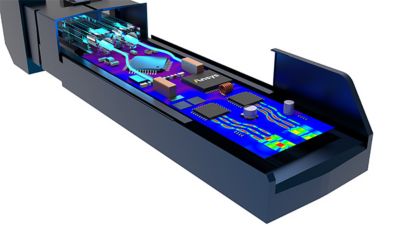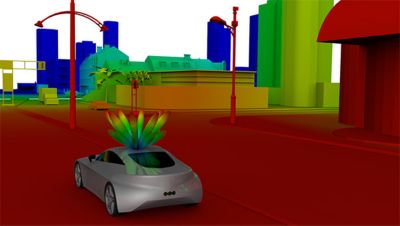-
-
학생용 무료 소프트웨어에 액세스하기
차세대 엔지니어에게 힘을 실어주는 Ansys
학생들은 세계적 수준의 시뮬레이션 소프트웨어를 무료로 이용할 수 있습니다.
-
지금 바로 Ansys에 연결하십시오!
미래를 설계하기
시뮬레이션이 다음 혁신을 어떻게 지원할 수 있는지 알아보려면 Ansys와 연결하십시오.
국가
무료 트라이얼
제품 및 서비스
학습하기
회사 정보
Back
제품 및 서비스
ANSYS BLOG
April 1, 2020
Integrated Photonics Technology: Model Communications & Sensors
Combined integrated photonics technology and electrical systems are an important part of 5G, autonomous vehicles and the internet of things (IoT). Photonic sensors and transceivers are a key component of data security, data communication and environmental detection because of cost, scalability, performance and energy efficiency.

A simulation of a fiber optical connector interacting with electronic systems
An everyday example is a fiber optical connector used in small form-factor pluggable (SFP) transceivers for datacenter and fronthaul 5G applications. This communication device uses light to transfer data over optical fibers between electronic systems. Engineers need simulation tools to model this and other integrated photonic systems, to ensure that:
- Photonic emitters/detectors are compatible
- Data transmission is optimized for speed, accuracy and energy efficiency
- Operation is robust over a range of environmental conditions
- Fabrication and packaging costs are minimized
- Data contents are secure
Engineers can then integrate these models to validate, optimize and design the complete system.
That is why Ansys is excited to announce the acquisition of Lumerical. They offer a photonic multiphysics solution with the capability to solve electro-optical systems, including thermal, charge-carrier and light emission effects.
A Theoretical Integrated Photonics Workflow to Design Lidar Systems
Lumerical’s user interface (UI) offers an integrated design environment (IDE) that can intuitively couple models that include optical, emissive, electrical, thermal and electromagnetic simulations. This multiphysics mindset fits the needs of those working on integrated photonics for 5G, autonomous vehicles and IoT applications.

Simulation of an autonomous vehicle’s lidar systems shows how accurately (red) or inaccurately (blue) certain objects are detected.
For instance, autonomous vehicles require low-cost lidar system sensors within their environmental detection systems. Using integrated photonic simulations, engineers will be able to assess the performance of the emitting laser, as well as the nanoscale integrated phased array (or liquid crystal) used to form and steer the beam. The propagation of the laser beam and its interaction with the environment is then modeled using macroscopic optical simulation technology — such as Ansys Speos. Then, engineers can use Lumerical technology to model how the integrated sensor receives the laser signal calculated from the macroscopic optical simulation.
Currently, when simulating lidar systems, Ansys users need to acquire integrated photonic information from measurements or vendors. By integrating these simulation technologies, engineers will be able create high-fidelity simulations that can help them optimize source and detector designs.
To help engineers simulate electronic systems and their interaction with photonic circuits, Lumerical has partnerships with various foundries to provide customers with high quality photonic process design kits (PDKs). As a result, by integrating their portfolio with the Ansys platform, engineers can simulate and characterize a full electro-optical communication or sensing system.
Learn more about integrated photonics.
Any and all ANSYS, Inc. brand, product, service and feature names, logos and slogans such as Ansys and Ansys Speos are registered trademarks or trademarks of ANSYS, Inc. or its subsidiaries in the United States or other countries.